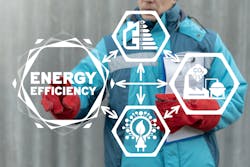Last month we discussed one way in which the digital transformation has impacted energy management — steam/power system optimization (“Get Less Steamed Up”). This month we turn to another way — energy performance indicators, or EnPIs.
Key performance indicators (KPIs) have been around a long time, and typically are used for financial-based measurements and comparisons. EnPIs extend the KPI concept to energy management and serve two distinct purposes: 1) high-level business management metrics based on monthly, weekly and daily production volume; and 2) actionable indicators to improve and maintain the operation and energy efficiency of plants, processes and equipment.
A high-level EnPI typically is a statistical model or regression analysis that examines the impact of various factors on the energy intensity (energy consumption/production) of a complete plant. Simple EnPIs are calculated based on a single pair of variables — most often, energy use and production rate. However, other variables also may be important. For example, ambient temperature, multiple heat flows into and out of a process area, differing energy densities of different products, or the quality or condition of raw materials, all can influence energy intensity. Multivariable regression analysis (MVR) can flush out the relationships between these factors.
EnPIs can help compare the performance of peer plants and track improvements over time, typically on a monthly basis. This can serve a variety of purposes. One example is “measurement and verification” for projects or programs. In this application, process conditions are measured and modeled both before and after the project or program is completed. This provides a view of energy savings on a normalized basis, taking into account changes in production volume, runtime, or any other variable included in the model to see how well the project has performed. Other applications are based on performance forecasts, which can serve to support budgets or set performance targets for plant operations.
Relatively simple systems with manual data entry can be used for high-level EnPIs. For example, you can download the U.S. Department of Energy’s Energy Performance Indicator Tool (EnPI) V5.1.5 at https://bit.ly/3fSpb6e; a Microsoft Excel add-in provides MVR capabilities.
However, high-level EnPIs do not provide enough insight on what’s happening in the plant to enable operators to drive performance in real time. To create actionable information, you need an energy management platform that can handle more complex requirements. Some oil refining and chemical companies have developed their own in-house platforms, and several “Energy Management Systems” are available commercially. (Note: The term “Energy Management System” also applies to the ISO 50001 energy management standard, and other programs intended to standardize practices. This terminology can cause some confusion.) Capabilities vary significantly between the various platforms, but key requirements include:
- More granular measurements within the plant. EnPIs generally are created for specific process units, systems or equipment items. These typically are the significant energy users within a plant or site.
- Shorter reporting intervals. Many plants choose a 15-min. data capture interval, which aligns with the 15-min. demand interval period most electric utilities use to calculate demand charges. At this frequency, manual data entry isn’t practical. Instead, plant measurements (e.g., flows, temperatures, pressures) are obtained from transmitters at the measuring devices, or via programmable logic controllers, distributed control systems, or plant historian systems.
- Performance targets. These are commonly based on “best performance” values derived from historical data. However, in some cases, they stem from plant simulations, or are determined by other methods.
- User interface or “dashboard.” This should be customized for the needs of specific users. For example, plant operators need to know in real time how the equipment under their care is performing against target. Some systems also provide online recommendations if performance doesn’t meet the target. Site energy leaders and engineers may need to see strategic information that helps them drive energy efficiency across the plant. Finance and plant management personnel typically have different needs focused on longer-term trends.
The potential energy benefits are similar to those of steam/power optimizers — i.e., around 3% of total site energy cost; often added benefits accrue from improved understanding of the plant and how it performs.
For more information, check out Alan Rossiter and Beth Jones, “Energy Management and Efficiency for the Process Industries,” AIChE/John Wiley & Sons, Inc., Hoboken, New Jersey, 2015, Chapter 27.
About the Author

Alan Rossiter
Energy Columnist
Alan Rossiter is a former contributor for Chemical Processing's Energy Saver column. He has more than 35 years of experience in process engineering and management, including eight years in plant technical support, design and research with Imperial Chemical Industries (ICI, United Kingdom) and nine years in energy efficiency and waste minimization consulting with Linnhoff March, before starting his own business. In 2019 he joined the University of Houston as Executive Director, External Relations for UH Energy. He is a chartered engineer (U.K.) and a registered professional engineer in the state of Texas. His latest book, Energy Management and Efficiency for the Process Industries, coauthored with Beth Jones, was published by John Wiley & Sons in 2015. He is a Fellow of the American Institute of Chemical Engineers and a Past Chair of the South Texas Section of the AIChE.
